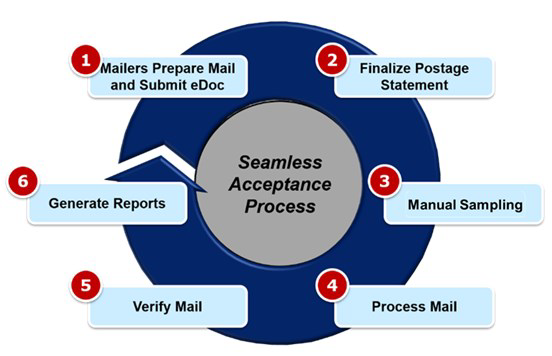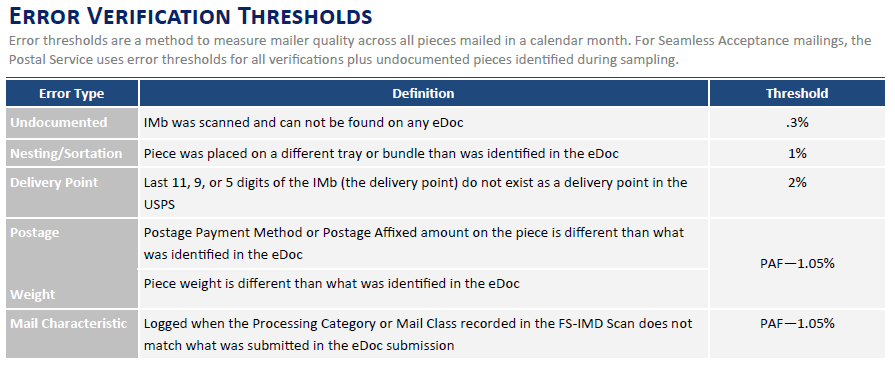Seamless Acceptance is designed to streamline the verification, acceptance, payment, and induction of mail. This program has benefits for both mailers and the USPS. Many mailers have adopted Seamless Acceptance and are very happy with the program, especially as they are realizing the benefits in their mailing operations. However, other mailers are hesitant to adopt Seamless Acceptance, mostly due to fears of potential expensive postage assessments for errors. To help stem those fears, let’s review the Seamless Acceptance program and steps mailers can take to avoid potential assessments.
Eligibility
To participate in this program, mailers must have 90% or more of their mail volume submitted as Full-Service mail. The mail pieces must be uniquely barcoded and submitted electronically (eDoc). If the mailer is preparing Detached Mail Unit (DMU)-verified origin entry or destination entry drop shipments, participation in eInduction is also required. Prior to participating in Seamless Acceptance, mailers must participate in an intermediate step called Seamless Parallel. This is essentially a testing period, during which time the mailer works with the USPS to ensure the volume and mail preparation and submission requirements are being met. This is one of the keys to reducing mailers’ fears: use the Seamless Parallel period to test your Quality Assurance processes, pinpoint issues for correction, and closely monitor your Mailer Scorecard.
How It Works
The current verification process involves manual verification by a USPS acceptance employee prior to entry and finalization. The employee performs a cursory review, collects Full-Service initial verification mail samples, conducts performance-based verification, and finalizes the postage statement.
- The mailer’s eDoc is validated to ensure it meets Seamless Acceptance criteria.
- Postage statements are auto-finalized on the postage statement mailing date.
- The Business Mail Entry clerk performs a sampling of the mailing using an Intelligent Mail Device (FS-IMD) by scanning one container, three sacks/trays/bundles, and 30 mail pieces.
- Dock clerks scan containers at induction (eInduction).
- Mail Processing Equipment (MPE) scans are collected as the mail is processed.
- Data collected from the FS-IMD, eInduction, and MPE scans is compared to the eDoc to identify any mail preparation errors.


Source: Seamless Acceptance Fact Sheet, December 2017
Benefits
- Verifications are performed electronically, reducing complexity
- Auto-finalization puts control of postage payment in the mailer’s hands
- Allows for longer production cycles
- Mailer control over mail release timing without USPS intervention
- Improved feedback and identification of trends
- Standardized acceptance and verification process (particularly valuable for mailers with multiple sites)
- Trend-based verifications measure quality across a calendar month rather than by mailing.
Essentially, this all means that your mail verification and acceptance process is much more streamlined, efficient, less time-consuming, and you have more control over the mail release schedule. Mailers should not let their fears of potential assessments prevent them from taking advantage of these benefits.
Best Practices to Avoid Assessments
- Monitor your Mailer Scorecard data daily. Watch for trends and pinpoint problem areas for correction early on. Use this data proactively as a source of feedback, and not as a penalty process.
- Implement stringent Quality Assurance processes to provide multiple checkpoints for preventing errors. Review the areas that are validated by the USPS as part of Seamless Acceptance and focus on putting QA processes in place specific to those areas.
- Implement a comprehensive logging process to track the generation of all unique Intelligent Mail barcodes. This may seem like overkill, but this is your best defense against undocumented mail pieces, which is one of the most feared assessments.
- Perform routine audits of your QA processes and tweak or update them as necessary. Also, these audits make sure that your staff are properly following these processes.
- Work closely with the USPS and ask for help. The USPS has a vested interest in making Seamless Acceptance work smoothly; their goal is properly prepared mail, not penalties.
- Work with your software providers and other suppliers to utilize tools and/or expertise in streamlining your mailing workflow, implementing QA processes, and researching Mailer Scorecard data.
Seamless Acceptance does not have to be a scary thing; educate yourself and take advantage of many available resources to help you adopt this beneficial program.
Resources
The USPS offers many resources for mailers interested in participating in Seamless Acceptance. Check out the following websites for more information:
- The Seamless Acceptance Fact Sheet: https://postalpro.usps.com/seamlessacceptactfactsheet
- The Guide to Seamless Acceptance: https://postalpro.usps.com/node/657
- The Publication for Streamlined Acceptance of Letters and Flats: https://postalpro.usps.com/StreamlinedMailAcceptLettersFlatsPub685
Jeff Peoples is Founder & CEO, Window Book. He is a sought-after speaker at many industry trade shows, including the National Postal Forum.
This article originally appeared in the July/August, 2019 issue of Mailing Systems Technology.















